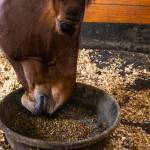Foreleg Conformation Faults in Young Horses

When a newborn foal stands for the first time, onlookers frequently comment on the baby’s incredibly long legs. These gangly limbs have been tightly folded inside the uterus, and the restricted space has led, in many cases, to forelegs that are not completely straight at the time a foal is born. Whether they are turned in, turned out, or swept sideways, a large number of these crooked legs will develop straighter conformation during the foal’s first six months, even without treatment.
In one study* of foreleg conformation, researchers followed 294 foals from birth to five or six months of age. The foals were of Thoroughbred, French Trotter, or Selle Francais breeding. Each foal was visually assessed by several observers for conformation faults. Almost 2/3 of the foals showed angular limb deformities during their first month, but most of the abnormalities became less severe or totally self-corrected within six months. In this study group, abnormalities were found more frequently in Thoroughbreds and French Trotters than in Selle Francais foals.
Fewer than 10% of the foals were given medical, surgical, or orthopedic treatment for forelimb conformation faults, and some serious faults self-corrected as well as minor imperfections. The researchers concluded that some degree of limb deviation can be considered normal in newborn foals, and many problems can be expected to resolve without treatment. Owners should consult a veterinarian to work out the best plan for management of conformation abnormalities in the forelegs of foals, though many of these imperfections may not need to be treated.
*”Longitudinal development of equine forelimb conformation from birth to weaning in three different horse breeds,” C. Robert, J.-P. Valette, and J.-M. Denoix. The Veterinary Journal (in press).








